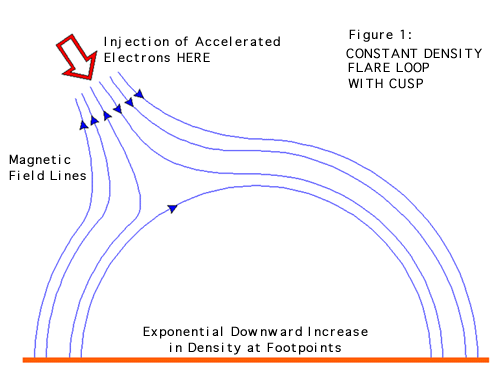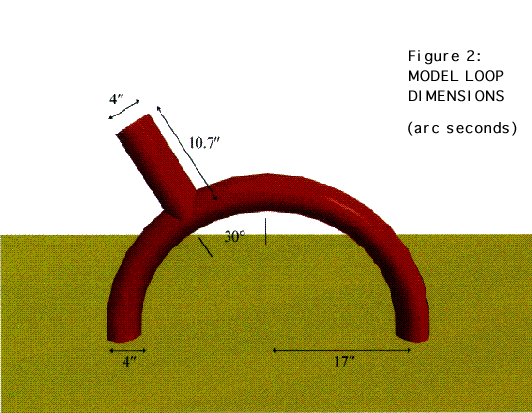
The purpose of the model is to provide a physically plausible explanation for the basic features of the Yohkoh x-ray observations, rather than attempt to reproduce the observational results in detail. This allows some assumptions to be made that substantially simplify the model calculations. To be useful, however, the model should provide specific information about the physical conditions required to obtain the observed features. It should also indicate how a similar flare would appear when additional observations are available. That is, it should make predictions.
The features of the model are represented in Figure 1. The basic structure is a magnetic loop with a cusp. The density of the thermal plasma is taken to be constant throughout the loop and cusp, except at the footpoints, where the density is much higher. Accelerated electrons are injected into the cusp at a constant rate. They travel down the cusp to the loop, where half of the electrons travel down one leg of the loop and half travel down the other. The electrons radiate x-ray bremsstrahlung because of their interaction with the thermal ions. They also lose energy through collisions with the electrons in the thermal plasma. The electrons that make it to the footpoints lose the rest of their energy in the dense plasma there.

The electrons are taken to be injected at the top of the cusp. This is a special place, since any x-ray emission is assumed to be negligible above this location and the electrons must be accelerated at or above this location. The magnetic field lines cannot simply end here, however, but must continue outward. Note from the blue arrows in Figure 1 that oppositely directed magnetic field lines are adjacent at the center of the cusp. Under these circumstances it is possible for a process called magnetic reconnection to occur, in which adjacent field lines "break" and form new connections with each other. Significant particle acceleration can be associated with this process. This is one way in which the top of the cusp can take on the special significance assumed in this model.
The specific geometry and dimensions of the model loop are illustrated in Figure 2. The loop is semi-circular with a circular cross section. The toroidal radius is 17 arcsec and the poloidal radius is 2 arcsec. The cusp is radially oriented and located 30 degrees from the vertical. The top of the cusp is 10.7 arcsec from the axis of the semi-circular loop. These dimensions are similar to those of the Yohkoh flare. Placing the cusp off center makes the distance from the top of the cusp to the left footpoint shorter than the distance to the right footpoint. This was done to assess the effect of the distance traveled through the loop plasma by the electrons on the relative brightness of the x-ray emission from the footpoints.

The thermal plasma in the loop is taken to have a temperature of 20 million
degrees Kelvin down to a height of 2 arcsec above the footpoints, and a much
cooler temperature below this height. This is done to simulate the cooler plasma
below the corona, and to ensure that in the computed images the nonthermal
x-rays from the footpoints are clearly distinguishable from the x-rays emitted by
the thermal plasma.
![]() Fast Electrons, Bremsstrahlung, and Bowling
Fast Electrons, Bremsstrahlung, and Bowling ![]()
![]()
![]() Next: The Injected Electrons
Next: The Injected Electrons
![]() Back: Images of a Flaring Loop in Hard X-Rays
Back: Images of a Flaring Loop in Hard X-Rays
![]() Solar Flare Homepage
Solar Flare Homepage
![]() Table of Contents
Table of Contents